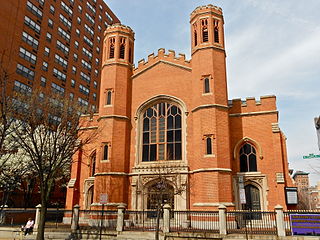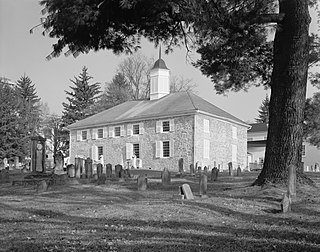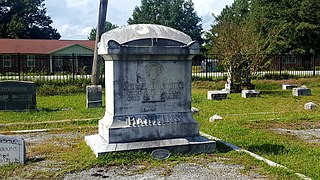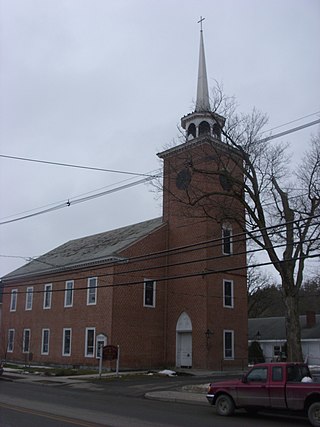
Westminster Hall and Burying Ground is a graveyard and former church located at 519 West Fayette Street in Baltimore, Maryland, United States. It is currently part of the grounds of the University of Maryland's School of Law. It occupies the southeast corner of West Fayette and North Greene Street on the west side of downtown Baltimore. It sits across from the Baltimore VA hospital and is the burial site of Edgar Allan Poe (1809–1849). The complex was declared a national historic district in 1974.

The Old Scotch Church, also known as the Tualatin Plains Presbyterian Church, is a church and national historic site located in an unincorporated part of Washington County, Oregon, near Hillsboro, Oregon, United States. The church dates to 1873 while the church structure with an eight-sided steeple dates to 1878. A cemetery on the church grounds holds the graves of church members and local pioneer settlers of the Tualatin Plains, including Joseph Meek.

The First Presbyterian Church of Chester is a Presbyterian church in Chester. It is located along NY 94 in the eponymous village in Orange County, New York, United States. The current church building, listed on the National Register of Historic Places in 1998, is the third in the history of the congregation, on as many locations. Two additions have been built but the building otherwise remains intact, a well-preserved example of a 19th-century rural American church.

The First Church of Hanover, also known as the First Presbyterian Church of Hanover or the Hanover Presbyterian Church, is located on Mount Pleasant Avenue in East Hanover, Morris County, New Jersey, United States. Established in 1718 in what was then the British Province of New Jersey, it is a member of the Presbyterian Church (USA) and is the oldest religious congregation in Morris County. The congregation's current building, constructed in 1835, is listed on the National Register of Historic Places.

First Presbyterian Church and Manse is a historic Presbyterian church located at West Madison Street and Park Avenue in the Mount Vernon-Belvedere neighborhood of Baltimore, Maryland, United States. The church is a rectangular brick building with a central tower flanked by protruding octagonal turrets at each corner. At the north end of the church is a two-story building appearing to be a transept and sharing a common roof with the church, but is separated from the auditorium by a bearing wall. The manse is a three-story stone-faced building. The church was begun about 1854 by Nathan G. Starkweather and finished by his assistant Edmund G. Lind around 1873. It is a notable example of Gothic Revival architecture and a landmark in the City of Baltimore.

Franklin Street Presbyterian Church and Parsonage is a historic Presbyterian church located at 100 West Franklin Street at Cathedral Street, northwest corner in Baltimore, Maryland, United States. The church is a rectangular Tudor Gothic building dedicated in 1847, with an addition in 1865. The front features two 60 foot flanking octagonal towers are also crenelated and have louvered belfry openings and stained glass Gothic-arched windows. The manse / parsonage at the north end has similar matching walls of brick, heavy Tudor-Gothic window hoods, and battlements atop the roof and was built in 1857.

The Old Presbyterian Meeting House is a Christian church located at 321 South Fairfax Street in the Old Town neighborhood of Alexandria, Virginia. It is part of the National Capital Presbytery and the Synod of the Mid-Atlantic of the Presbyterian Church (USA).

Trinity Church is a historic Episcopal church, located in a small cemetery on New Hampshire Route 175 in Holderness, New Hampshire. Built in 1797, it is one of only two surviving 18th-century buildings in the state that was built as a church. It is also the only major surviving structure associated with the life of Samuel Livermore, a prominent New Hampshire statesman and jurist. The church was listed on the National Register of Historic Places in 1984. It is maintained by the cemetery's association, and is occasionally used for services.

First Presbyterian Church is a historic church located at 120 East State Street in Trenton, Mercer County, New Jersey, United States. The church's first congregation got together in 1712 and their first church was built in 1726. The church building and churchyard cemetery were added to the National Register of Historic Places for their significance in architecture, politics, religion, and social history on September 9, 2005.

The First Presbyterian Church is a historic church building in Columbia, South Carolina. Constructed in 1854, it was added to the National Register of Historic Places on January 25, 1971.

Old Stone Church is a historic Presbyterian church located at Lewisburg, Greenbrier County, West Virginia.
Manchester Cumberland Presbyterian Church is a historic Cumberland Presbyterian congregation in Manchester, Tennessee. Its former church building, also known as the Church Street Theatre, is listed on the National Register of Historic Places.

Old Kingsport Presbyterian Church is an historic church located in Kingsport, Tennessee. The church was organized May 20, 1820 as the Boatyard Congregation. It is the oldest one of any denomination in the city of Kingsport. It is a member of the Presbyterian Church (U.S.A.).

The Big Run Baptist Church and Cemetery, also known as Franklin Township Historical Society, is a historic Baptist church and cemetery located at 6510 South Franklin Road in Franklin Township, Marion County, Indiana. The church was built in 1871 as a Baptist meeting house and served the church congregation until 1977. It is a one-story, gable front brick building with Italianate style design elements. The associated cemetery was established in 1854, with one stone dated to 1841. The most recent burial was in 1986. Also on the property is a contributing privy constructed about 1920. The Franklin Township Historical Society acquired the property and now uses the building as a historical museum.

Union Church, also known as Brick Church, is a historic church building located in Davis City, Iowa, United States. For the first 20 years of its existence, Davis City did not have a church. This church was built at the instigation of John Clark in 1878. Clark was a native of Scotland who was of no particular religious affiliation, but thought "the moral and religious training of the Christian faith of fundamental importance." The church building was accessible to all denominations, and is now owned jointly by Methodist, Presbyterian, and Christian congregations. It was added to the National Register of Historic Places in 1976.

The Frenchman's Mountain Methodist Episcopal Church–South and Cemetery is a historic church in Cato, Arkansas. Located at the junction of Cato, Frenchman Mountain, and Camp Joseph Robinson Roads, it is a single-story wood-frame structure, built in 1880 as a two-story building to house both religious services and the local Masonic lodge. The upper story, housing the lodge facilities, was removed in 1945. The congregation was organized in 1872 in Cato, the oldest community in northern Pulaski County. The church declined after most of the land in the area was taken to establish Camp Joseph T. Robinson, with the church now enclaved within its bounds.

The Prosperity Cemetery is located on McNeary Street on the south side of Prosperity, South Carolina. The cemetery is about 3 acres (1.2 ha) in size, with more than 1,000 marked graves dating back to its founding in 1802. The cemetery is distinctive for the fine quality of its funerary art in what is essentially a rural backcountry setting, and for the unusual concentration of gravestones that were signed by local merchants and stonecutters. The cemetery was established as the burying ground for a Presbyterian congregation, but is now managed by a local cemetery company and now serves as the town's main cemetery.

St. Paul's Lutheran Church Historic District, also known as Schoharie United Presbyterian Church, is a historic Lutheran church complex and national historic district located at Schoharie, Schoharie County, New York. The complex consists of the former St. Paul's Lutheran Church, an 1801 manse, St. Paul's Lutheran Cemetery, and the old Lutheran Parsonage. The church was built in 1796, and is a two-story rectangular brick building. The front facade features a square, multistage entrance tower capped by an octagonal belfry and spire. The new manse was built in 1801, and is a five bay, two-story, double pile, heavy timber frame Federal style dwelling with a two-story rear ell. The church cemetery has several thousand graves, with the earliest marked grave dated to 1778. The Old Lutheran Parsonage was built in 1743, and is separately listed. In 1920, the local Lutheran and Methodist congregations joined, and in 1960, the congregation voted to affiliate with the Presbyterian denomination.

Cottage Grove Avenue Presbyterian Church is a historic building located in Des Moines, Iowa, United States. It was listed on the National Register of Historic Places in 2016.

The Old Stone Church is a historic sandstone church located in Kingwood Township in Hunterdon County, New Jersey, United States. It was built in 1837 and is now owned by the First Unitarian Universalist Fellowship of Hunterdon County. The church, described using its historic name, Old Stone Presbyterian Church in Kingwood, was added to the National Register of Historic Places on January 25, 2018 for its significance in architecture. The earlier church located here was a smaller stone building built in 1755, called the Old Stone Meetinghouse. The stones from this church were probably used to build the current one. The Kingwood congregation was established in 1728 and grew during the First Great Awakening, with Gilbert Tennent and George Whitefield preaching here in 1739.





















